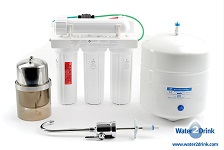
Pros and Cons of Reverse Osmosis Treated WaterSunday, November 30, 2014 - by Water2Drink
We here at Water2Drink.com want to be sure you have the
information you need to make an informed choice about your water filtration system. We want to talk to you, our customer, to gain
insights into your water filtration needs, such as how many people will be
using the filter, what type of water resource serves your area, and any
potential health hazards in your water supply that must be addressed. We strive to help you obtain the most
efficient, cost-effective Multipure Water Filtration System to meet your personal needs.
We often receive inquiries about using a reverse osmosis
(RO) water filtration system. Many
people are under the mistaken belief that, if removing dissolved contaminants
is healthful, then removing ALL dissolved minerals will be even more
healthful. This is simply not the
case. While there are times when an RO
system is exactly what is needed, most often an #RO system will remove the good
with the bad, according to University of Wisconsin health family medicine
physician Jacqueline Gerhart.
If you were to compare the pros and cons of an RO system,
you would find the list to be somewhat unbalanced. Very briefly, here is a short list of pros
and cons that we came up with to help you understand that sometimes less is
more.
The pros of having a Multipure 5-step Reverse Osmosis
drinking water system include:
However, there are many cons that must be considered as
well. For example, an RO filter:
While certain circumstances dictate the use of a Multipure
AquaRO drinking water system, most often your health goals can be better met by
another Multipure product family.
Contact #Water2Drink today to ask questions and get answers to help you
decide what is right for you. |
|
Tweet
|
Leave a Comment


 Comments
Comments